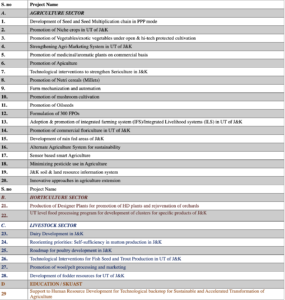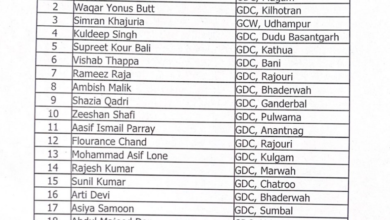J&K: With Rs 5000 Cr Bonanza, Aims To Increase Annual Output By Rs 28000 Cr, Employment For 2.8 Lakh | Know Details
JAMMU: The Jammu and Kashmir government has approved 29 projects with total outlay of Rs 5013 Crore to transform the agriculture economy of J&K in the next year, while seeking to increase the agriculture output by Rs 28000 crore annually and providing employment opportunities for more than 2.80 lakh youth across the union territory.
This has been envisioned in the UT government’s new scheme- Holistic Development of Agriculture & Allied Sectors, which is among the three new schemes—the two other being Aspirational Towns Development Programme and Aspirational Panchayat Development Programme—announced by the Lieutenant Governor, Manoj Sinha on Wednesday.
All these projects have been approved by the Administrative Council—equivalent to cabinet in the popular government, chaired by the Lt Governor in the recent past.
Holistic Development of Agriculture & Allied Sectors
The first of these schemes, and the most important of the lot, deals with holistic development of Agriculture & Allied Sectors. On the suggestions of an Apex Committee set up in July this year, the government has formulated a comprehensive plan in the form of 29 projects covering all the sectors within the ambit of APD.
The projects which have now been approved by the administrative council and having an outlay of Rs. 5013 crores over the next five years shall transform the agriculture economy of J&K putting it on a new trajectory of growth, doubling the output of the sectors, boosting exports and making the sectors sustainable & commercially viable. This will herald a new phase of farmer prosperity and rural livelihood security in J&K, said an official handout.
“The unique thing about these projects is not only that they have been prepared by some of the finest brains in the country but also the fact that their formulation was undertaken in a consultative mode – ensuring that the opinion of all stakeholders including our farmers are taken onboard. Having gone through the contents of the projects that have been cleared by the committee and their expected outputs and outcomes, I am confident that a new revolution in the agriculture and allied sectors of the UT is on the anvil. J&K is determined to move forward to touch new heights of success,” said LG Sinha.
These 29 projects will almost double the output of the sectors, boosting exports and making the sectors sustainable & commercially viable. These gains will be equitable, reaching the last person in the pyramid and ecologically sustainable through efficient use of bio-resources for food, feed & industry.
The agricultural output which stands at Rs 37600 crores shall increase by over Rs 28142 crores to reach more than Rs 65700 crores per year, with a resultant increment in sectoral growth rate to 11%.
The government said that these interventions will create employment opportunities for over 2.8 lakh youth and establish around 19,000 enterprises.
“More than 2.5 lakh persons shall be skilled in various agri-enterprises ranging from seed production, precision farming of vegetables, bee-rearing, cocoon production, mushroom farming, integrated & organic agriculture, high-density fruit farming to processing, dairying, sheep & poultry farming as well as fodder production. In the next five years the UT shall have a motivated workforce with agri-entrepreneurial skills in a commercially viable and ecologically sustainable agri-ecosystem,” it said.
These 29 projects have been segregated into four sectors viz agriculture, horticulture, livestock and education/SKUAST.
The government listed the major outputs and likely outcomes of these 29 approved projects which include achievement of recommended Seed Replacement Rate by cultivation of 2.596 lakh QTLS of quality seed, which will result in production increase between 15%-45% depending on the crop; boosting of niche crops like saffron, kalazeera, rajmash, basmati etc by bringing additional 11000 Ha under their cultivation through diversification while new nurseries and seed villages will be established to provide quality plantation material; and an increase in vegetable production from 19.90 lakh to 25.87 lakh MT, along with 1100 hi-tech green houses and 3548 polyhouses to be established with an upscaling of cropping intensity to 250%.
The government said it will create an intensive network of post-harvest and marketing value chains from Rural Business & service hubs, reefer vans to mandis, from grading lines to branding centers with integrated 67,000 MT of CA Storage Space, along with a dedicated backend market intelligence cell to extend marketing decision support to farmers in real-time.
The other major outputs and likely outcomes listed by government include:
- A new dawn in Medicinal & Aromatic plant sector by cultivation of MAPs on more than 250 ha of land with a potential sectoral output of 750 crores (15 years).
- Tripling of Honey Production from 2200 MT to 6610 MT beside generation of Rs. 475 crores per year from value added by-products. Spinoff effect on crops that rely on cross pollination by increase in bee numbers.
- Doubling of silkworm seed and cocoon production and regaining of J&K’s glory as a producer of high-quality bivoltine silk. Planting of 10 lakh mulberry trees and creation of a state-of-the-art automatic reeling facility.
- Focus on climate resilient millet crop and nutri-cereals cultivation on 14,000 ha area in Kandi/Rainfed belts. Doubling of per hectare productivity of millets and establishment of 60 millet processing units.
- Increase in farm power from present 1.74 Kw/ha to 2.5 Kw/ha. Establishment of 283 Custom Hiring Centre & 142 AI & precision farming centers.
- Diversification in farm income through boost in cultivation of mushrooms. Quadrupling mushroom production from 2100 MT to 7800 MT. Value addition through establishment of 4 Mushroom Canning & pickling Unit.
- Doubling in production of Oil seeds & increasing area under cultivation from 1.4 lakh Ha to 2.1 lakh Ha.One hundred new Oil seed extraction units will be established for value addition. Increase in per hectare productivity from 800 to 1200 kg.
- Creation of 300 FPOs encompassing 3000 farmer interest groups (FIGs) by mobilization of 60 thousand farmers in each block of J&K. Net returns to farmers as a result of collectivization will increase by 10-12%.
- Integrated farming systems, integrated organic farming systems & integrated livelihoodsystem will be established by involving 85,000 farmer families in drought prone & rain-fed areas. Enhanced farmer income (1:2.01 CB Ratio), and increased income per hectare by 100%.
- Harvesting J&K’s agro-climatic diversity in cultivation of temperate and other cut flowers through strengthening of existing 150 units and creation of new 54 nurseries & 330 production units.
- 50% increase in Fruit Economy from Rs 10,000 cr/year to Rs 15,000 cr/year. 7500 ha additional area will be brought under high density fruit cultivation, 11 million new plant material will be produced along with 200% increase in productivity in existing orchards.
- Seven product clusters in 17 districts handling 20 Lakh MT produce shall be mobilized. Five Mega Clusters will be established with grant of Rs 50 crore each. (Milk, Walnut, Meat & poultry, Vegetables and Basmati), along with One Midi-Cluster (Cherry) with grant of Rs 25 cr & One Mini Cluster (Trout) with grant of Rs 12.5 cr. Net revenue generation of over Rs 1450 crore per year.
- Milk output will increase by 75% and milk entering the processing chain will be tripled. Breeding cover improved from 30% to 70% & conception rate by 10%. Creation of facilities for production of sexed semen within J&K with an aim to replace 50% normal semen with sexed semen. Establishment of 500 village level milk collection units & 50 bulk milk chillers. Village level value addition of 110 lakh liters of milk into traditional products. Per animal milk productivity increased from 2400L PA to 4300L PA.
- Self-reliance in mutton will be achieved with sustainable wool & pelt value chains. Importation of 2700 heads of superior muttonous breeds of sheep shall be undertaken to effect genetic improvement in the sector. Implementation of ETT & AI programs to intensify genetic improvement and horizontal growth. Overall 300% increase in returns from wool & pelt to further secure livelihood of the traditional sheep & goat farmers.
- Self-sufficiency in poultry meat and egg production will be achieved. 300 feed production units, 125 integrated hatcheries & 200 big layer farms will be incentivized in private sector. 60 crore eggs and 6500 MT for free-range meat will become available annually from the backyard sector. Prevent a capital flight of Rs 1273 cr/yr.
- The production of Trout & Carp will be doubled by introducing fresh germplasm imported from Europe along with modernization & establishment of new hatcheries. Implementation of modern technologies in water management and rearing by establishment of raceways, RAS&bio-floc. Establishment of thirteen fish feed mills four cold storage cum ice production units and four quality-cum-disease control labs.
- The huge Fodder Deficit of J&K will be reduced by 80% through establishment of farmer demo plots (on 4100 ha/year), hay-silage units (300), fodder depots (25) and of hydroponic units (500 units with 15,000 MT green fodder output). In addition, generation of 20 lakh MT of fodder shall be undertaken from orchards, forest closures & alpine/sub-alpine grasslands.
- To boost extension and lab to land services 2000 Kissan Khidmat Centres (KKCs) for participatory planning and decentralized decision making will be established to promote remunerative agriculture at panchayat levels. The KKCs will ensure strong linkage with KVKs, line Departments, and universities for technical support leading to holistic area specific agricultural plan and models, service delivery at farmer doorsteps and impact analysis of schemes.
The official handout said that apart from addressing the major challenges facing the agriculture and allied sectors, the projects also undertake prospective planning in the form of establishing standards & facilities for organic plantations, developing region specific farm machinery, demonstration of sensor based smart farming models, developing a GIS and soil testing based online repository for efficient soil and land use, minimizing pesticide use through development of bio-pesticides and advanced spraying technologies as well as support for next generation of agri-technocrats through a program of technological backstopping.
“I am sure that the J&K of the future will be a role model for the whole country in its agricultural practices and prosperous farming community,” the Lt Governor said.
Aspirational Panchayat Development Programme
The Jammu and Kashmir is also rolling out this ambitious APDP program across the union territory, besides to select the most backward 285 Panchayats, one from each block, for their holistic development.
The government has already identified an array of key parameters for the preparation of Panchayat Development Index to rate the various Panchayats of the UT on socio-economic indicators concerning the lives of the people residing in the rural areas. This exercise will be taken upon the analogy of Aspirational Block Development Programme being implemented by the UT of Jammu and Kashmir.
A total of 100 measurable indicators have been identified across 9 Sectors namely Agriculture & allied Activities (06 indicators), Health & Nutrition (11), Education (13), Rural Development & Sanitation (07), Beneficiary-Oriented Schemes (04), Skill Development (04), Basic Infrastructure (17), Environment (05) & Good Governance (33), which will give insight of existing status and incremental progress over a period of time.
On the basis of importance of these sectors, weights will be assigned to each sector and sub-indicators as per relevance in the life of rural population.
These Aspirational Panchayats will be developed through convergence of various ongoing District and UT Schemes and Centrally Sponsored Schemes and Programmes, the government said.
“Additional financial assistance of Rs. 10 Lakh shall be provided to the selected Panchayats under the scheme for its further development after achieving saturation in the following parameters like Soil Health Cards, Land Pass Books, Kisan Credit Cards, Shram Cards issued to eligible Laborers, 100 percent Institutional Births,100 percent vaccination of children in the age group of 9-11 months, Zero Percent Out of School Children, 100 percent Solid Waste Collection & Treatment, Aadhaar Seeding with MGNREGA Cards, Issuance of Golden Cards under PMJAY SEHAT,” it added.
The government will select 285 most backward Panchayats from 4291 Panchayats of UT of J&K (One Panchayat per Block), on the basis of least aggregate score obtained on the selected 100 parameters/indicators in the Panchayat Development Index in the concerned Block. The data will be analyzed in PD&MD and most backward Panchayat in the Block shall be identified, the details of which shall be shared with all respective District Development Commissioners for their authentication.
The government said it will develop an Aspirational Panchayat Development Programme (APDP) Dashboard for uploading the data of all Panchayats on the selected indicators/parameters, and which will be used to monitor the progress of these Aspirational Panchayats on Key Performance Indicators.
The APDP will be implemented under the overall supervision of the District Development Commissioner (DDC), who will designate a Nodal Officer at district level from the Rural Development Department, for its smooth implementation.
“Panchayat Development Index will be introduced to develop and replicate best practices that drive improvement across the socio-economic themes of Panchayats. The identified Panchayats will be given special focus to saturate the inclusive development schemes and serve as model Panchayats,” said an official handout.
Moreover, access of people of these Panchayats to various schemes available for development of the poor, shall be improved/saturated, which shall bring overall improvement in educational level, health & well being and their living conditions. This will be a move forward towards inclusive development of these areas ensuring benefits to the last man standing in the row, it added.
Aspirational Towns Development Programme
The third major scheme to be rolled out is “Aspirational Towns Development Programme” (ATDP), besides the Urban Reform Incentive Fund (URIF) to incentivize undertaking of reforms in Municipalities, and the Assessment Framework for rating various Municipalities.
The government said that while Jammu & Kashmir Municipal Development Index will act as a guide to evidence-based policy making, catalyse action to achieve broader developmental outcomes, including the Sustainable Development Goals, assess and compare the outcomes achieved by municipal bodies, give citizens an insight into the functioning of local bodies and build a dialogue between the stakeholders, the URIF will provide necessary financial incentive to Municipalities to undertake reforms, in their journey of becoming Aspirational Towns.
The assessment framework examines the sectoral performance of Municipalities across a set of 7 verticals/pillars, namely Quality of Life and Services; Economic Ability; Technology; Urban Planning, Governance, Sustainability & Climate Resilience and Citizen Perception, which include 37 sectors/categories and 138 indicators.
Based on the performance of these Municipalities, as per the benchmarks prescribed under J&K MDI-2022, while best performing Municipalities will be encouraged and incentivized though additional grant-in-aid in the form of URIF (Urban Reform Incentive Fund), special funds will also be provided for building capacities and covering gaps in these Municipalities.
“It is our responsibility and resolve to ensure that the aspirations of the people get fulfilled,” the Lt Governor said.














